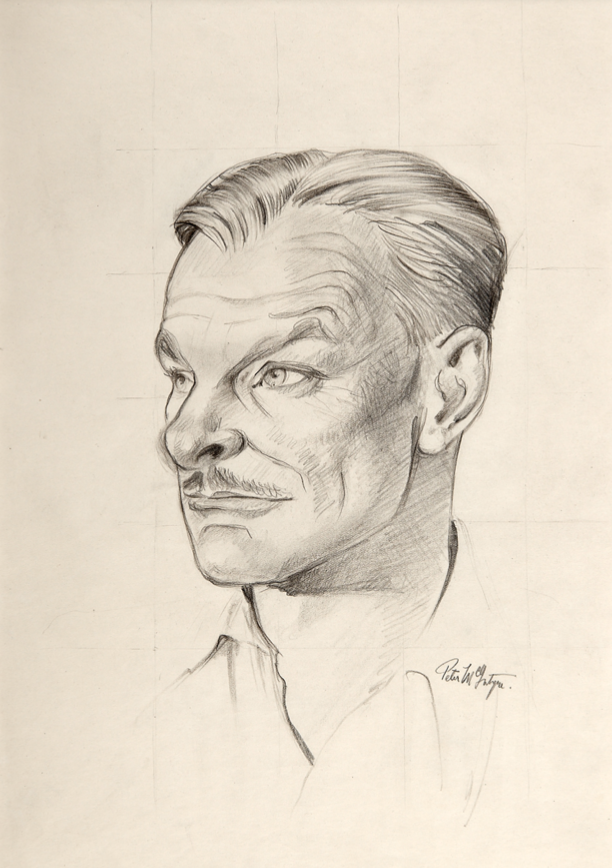Colonel S. M. Satterthwaite, 26th Btn.
Also exhibited as ‘Major S.M Sattrrtherwaite 26th Btn.’
Graphite on paper
29 x 20 cm
Signed lower right
PROVENANCE
Neville Colvin Collection. England
EXHIBITED
Jonathan Grant Galleries, Peter McIntyre 2nd NZEF War Drawings 1941 - 1944, 2010
ILLUSTRATED
(2010) Peter McIntyre 2nd NZEF War Drawings 1941 - 1944 [Exhibition Catalogue]. Auckland, New Zealand: Jonathan Grant Galleries.
Lt. Col. S. M. Satterthwaite
Timaru 1897 - 1977
Colonel Stanley Middleton (Jock) Satterthwaite served overseas in both the First and Second World Wars, and went on to become a prominent Timaru businessman.
Declining a catedship to the Royal Military College, Duntroon, he enlisted in the army at the age of 19. In April 1917 he embarked from Wellington for service with the New Zealand Rifle Brigade in France, with the 25th Reinforcements New Zealand Field Artillery. Early in 1918, while acting alone as a brigade intelligence officer, he was severely wounded when shot by a German sniper near Baupaume. On his return to New Zealand after the war, he joined the regular army.
In 1921 he moved to Dunedin and held the post of adjutant in three southern battalions for the next 16 years. In 1926, he was promoted to Captain. In 1940, by now a commandant of the District Military School in Burnham in the rank of Major, Satterthwaite was appointed second-in-command of the 25th (Wellington) Battalion. In June of that year, he embarked overseas with the Third Echelon of the 2nd NZEF.
After serving on Greece and Crete, he held several appointments in the Middle East, including second-in-command of the 25th Battalion, commanding officer of the 26th Battalion, and after being promoted to Lieutenant Colonel, assistant adjutant-general at the 2nd NZEF headquarters. He was Mentioned in Despatches before returning home in 1942 to become commandant of the NZ Tactical School at Wanganui.
A popular and efficient leader, Colonel Satterthwaite was described by the Minister of Defence at the time, Mr F. Jones as one of New Zealand’s most valued senior officers. He died at the age of 80, in Wellington.
The Neville Colvin Collection
(New Zealand 1918 – 1991 Britain)
Known to his friends as ‘the Count’ for his distinctive features, and to thousands as the creator of ‘Clueless’, Neville Maurice Colvin was born and raised in Dunedin. The first expressions of his drawing talent included contributions to the Otago Boys’ High School annual magazine. With the onset of World War II, training to be a teacher was replaced with commando training in Australia. Colvin arrived in Egypt in October 1941 and worked as a draughtsman with one of the infantry brigades of the 2nd New Zealand Division at Maadi. In his spare time he began contributing drawings to the New Zealand Expeditionary Forces Times.
In 1942 Private Colvin joined H.Q. 5th Brigade at the city of El Alamein, Northern Egypt. He cursed the bugs, the sun, the sand, the brass hats and all the other targets of an irritated soldier, yet from his hole in the ground he still managed to produce witty and humorous sketches for the N.Z.E.F. Times. To procure a chuckle out of 40,000 disillusioned soldiers was undoubtedly a milestone in the artist’s fledgling career. Towards the end of the Second Battle of Alamein he was hit in the leg, during a sudden airfield attack by nine fighter-bombers. He saw the campaign out with the Division and returned to Maadi in May 1943. He was then seconded to the Public Relations Service as a draughtsman.
Lance-Corporal Colvin proceeded to Italy with the PRS in early 1944, setting up headquarters in the port of Bari. By now he was one of the best-known artist contributors to the N.Z.E.F. Times. Here, he drew the original ‘Clueless’, the quintessential medal-bedecked, worn out and befuddled veteran. In early 1945 the nincompoop was released to the troops; he was an instant hit. The name quickly became a sobriquet for the gullible half-wit or unreliable vehicle in every unit, and for brigadiers and batmen, colonels and corporals alike his tomfooleries became a rare, weekly thrill. As The Jayforce Times wrote in 1947: “…even the normally staid, the meticulously military, were known to unbend.” Undoubtedly, it was Colvin’s regular interaction with the men in the Division and his past experiences at Alamein that saw him always hit the comic mark.
In 1945 Sergeant Colvin returned to New Zealand and decided to continue doing that which had given him so much satisfaction while abroad. From 1946 to the mid-1950s he was a political cartoonist for The Evening Post in Wellington. Then, following the trend of other antipodean graphic artists Colvin ventured to London. After working for The Daily Sketch and freelancing for major newspapers such as The News Chronicle and The Daily Telegraph, he turned to focus on strip cartooning. His best-known strip was the Evening Standard’s ‘Modesty Blaise’ by Peter O’Donnell, which he drew from 1977 – 1986. A lampoon on ‘James Bond’, the strip was run by in 44 countries, and in total he drew 1,902 episodes. Many reprints and several film adaptations have been made of this popular comic.
Neville Colvin’s flair for capturing the essence of topical situations and the idiosyncrasies of his subjects with a distinctively bold line and minimal use of text makes him deserving of placement in the annals of not only New Zealand’s art history, but that of Britain, where during his lifetime he was considered her pre-eminent line artist. The drawings in this exhibition, produced during the WWII years, are especially meaningful. Not only did they succeed in making light out of arduous times and bringing rare merriment to our hardworking troops, but in producing them Colvin realised where his passion lay, leading to his valuable contributions to the world of cartoon and illustration on an international scale.
Author: Dr. Warren Feeney


